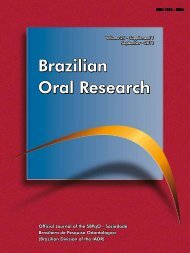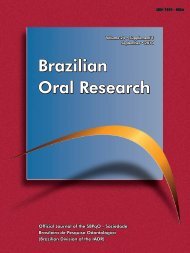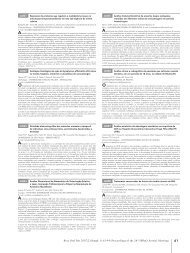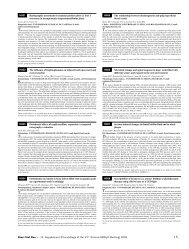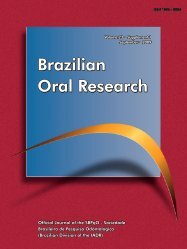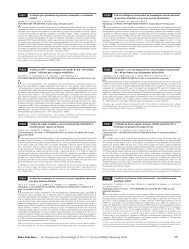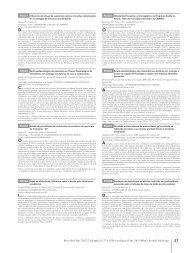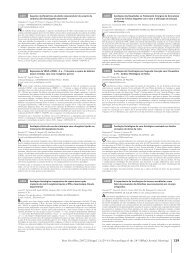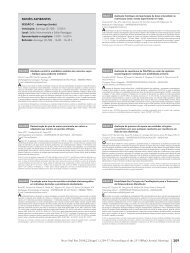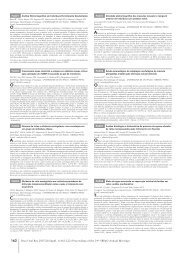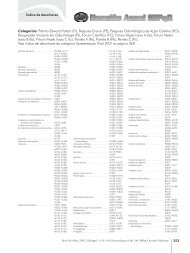Brazilian Oral Research Brazilian Oral Research Brazilian Oral
Brazilian Oral Research Brazilian Oral Research Brazilian Oral
Brazilian Oral Research Brazilian Oral Research Brazilian Oral
You also want an ePaper? Increase the reach of your titles
YUMPU automatically turns print PDFs into web optimized ePapers that Google loves.
Halitosis: A review of associated factors and therapeutic approach<br />
activity of the product was due to its anti-microbial<br />
action. 53 That conclusion became the basis for the<br />
premise that anti-VSC agents would succeed if they<br />
had an antimicrobial component.<br />
Rinsing with an EOs mouthrinse can have longlasting<br />
effects in reducing anaerobic bacteria overall<br />
as well as Gram-negative anaerobes and VSC<br />
producing bacteria. The significant reductions in<br />
numbers of these bacteria produced by the EO<br />
mouthrinse, both in plaque and on the dorsum of<br />
the tongue, can play a key role in explaining the EO<br />
mouthrinse’s effectiveness in reducing supragingival<br />
plaque and gingivitis as well as its effectiveness in<br />
controlling intrinsic oral malodor throughout the<br />
test period of 14 days. 54<br />
Triclosan<br />
The clinical experiments performed by Young et<br />
al. 55 (2002) showed that mouth-rinsing with triclosan<br />
solubilized in sodium lauryl sulfate, propylene<br />
glycol and water gave a marked and long-lasting<br />
anti-VSC effect. It cannot be excluded that sodium<br />
lauryl sulfate contributed to the observed anti-VSC<br />
effect. However, the in vitro experiments described<br />
by the authors support the contention that triclosan<br />
exhibits an anti-VSC effect per se.<br />
In the Carvalho et al. 50 (2004) investigation,<br />
plaque formation was not always directly associated<br />
with VSC measurements, since the triclosan and<br />
CPC mouthrinses were more effective in reducing<br />
bad breath than in reducing supragingival plaque<br />
accumulation. Therefore, it could be postulated that<br />
the superior reducing effect of these specific mouthrinses<br />
on bad breath may be related primarily to<br />
their efficacy in reducing the load of VSC-related<br />
microorganisms and oral debris in the whole mouth<br />
niches rather than only in supragingival plaque reduction.<br />
Cetylpyridinium chloride<br />
Quaternary ammonium compounds, such as<br />
benzalkonium and cetylpyridinium chloride, inhibit<br />
bacterial growth, but reviews concluded that the results<br />
were modest for plaque and equivocal for gingivitis.<br />
A CPC rinse used in a 6-week pre-brushing<br />
study failed to confer any adjunctive benefit to oral<br />
0 Braz <strong>Oral</strong> Res 2008;22(Spec Iss 1):44-54<br />
hygiene and gingival health compared to a control<br />
rinse. 56<br />
Although there is still debate over the action of<br />
cationic antiseptics in the oral cavity, what is clear is<br />
the lack of substantivity of cetylpyridinium chloride.<br />
This is highlighted by a persistence of antimicrobial<br />
activity of CPC in the mouth of only 3 h, which compares<br />
poorly with the greater than 12-hour action of<br />
CHX. 57 A more frequent use of CPC could improve<br />
plaque inhibition, but is likely to lead to compliance<br />
problems. Some studies also demonstrated that the<br />
CPC mouthrinse presented the lowest impact in<br />
reducing VSCs of morning breath when compared<br />
with other products. 50,51 This fact could be supported<br />
by the observation that this quaternary ammonium<br />
compound agent is not substantive enough to<br />
promote an essential antibacterial activity. 49<br />
Zinc<br />
Metals such as zinc, sodium, tin and magnesium<br />
are thought to interact with sulfur. The mechanism<br />
proposed is that metal ions oxidize the thiol groups<br />
in the precursors of volatile sulfur-containing compounds.<br />
58<br />
Morning breath odor can be successfully reduced<br />
by the sole use of an amine fluoride- stannous<br />
fluoride-containing mouthrinse twice daily, which<br />
significantly reduces the bacterial load in the saliva<br />
and retards the de novo plaque formation. 59 Unfortunately,<br />
both cupric and stannous ions have the potential<br />
to discolor teeth, either as a result of sulfide<br />
formation on the teeth after extended periods of use<br />
or due to the precipitation of dietary chromogen.<br />
Nonetheless, cupric chloride is the most effective<br />
metal solution for inhibiting hydrogen sulfide production<br />
at 1, 2 and 3 h after rinsing. 60 Zinc is the<br />
metal ion of choice with this purpose because of its<br />
low toxicity and its other favorable properties, such<br />
as not causing dental staining. It is known that zinc<br />
ions possessing anti-VSC effects have affinity for<br />
sulfur, forming sulfides with low solubility.<br />
<strong>Oral</strong> products containing zinc are also effective<br />
in reducing or inhibiting oral malodor. In a study<br />
conducted by Young et al. 51 (2003), a 1% zinc acetate<br />
solution had excellent anti-VSC effect throughout<br />
the test period of 3 h, although the metallic taste



